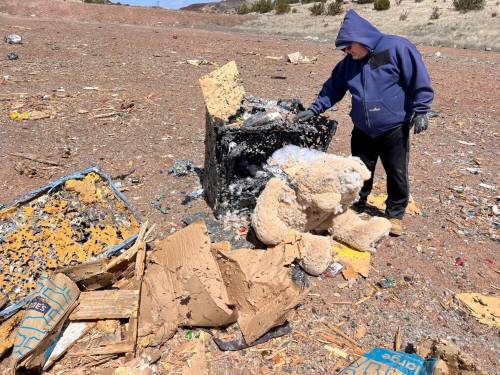A memorable journey across a significant New Mexico landscape helps hikers see the confluence of cultures
June 22, 2023

Menaul School students and faculty hiked New Mexico’s Caja del Rio ahead of Earth Day. (Photo by Andrew Black)
In honor of Earth Day in April, I had the opportunity to take out 70 students and faculty from Menaul High School in Albuquerque, New Mexico, for a guided hike and day of service on the Caja del Rio, one of the most significant cultural, historical, archaeological, spiritual and wildlife landscapes in the American Southwest. Sadly, it’s also considered one the most endangered landscapes in New Mexico as it faces huge threats from climate change, mining, illegal dumping and shooting, poaching, vandalism and theft of ancient petroglyphs and unlawful off-highway vehicle use that disrupts wildlife and cultural sites.
The Caja del Rio is a sacred landscape of great journey. For what originally started as wild game migration trails became Pueblo footpaths. Thousands of years later, one of these footpaths became the famed El Camino Real de Tierra Adentro, the trade route that ran from Mexico City to Ohkay Owingeh. Centuries later, portions of this trade route were designated as New Mexico Highway 1. A few decades later, these portions of NM 1 crossing the Caja became part of Route 66, the “mother road” that called forth westward expansion.

Students’ efforts to clear away tumbleweeds revealed this wall of petroglyphs. (Photo by Andrew Black)
For thousands of years, the Caja del Rio has told the complex story of the confluence of cultures and people in New Mexico and the American west. This area has spoken to the sacred connection between people, land, water and wildlife that makes us who we are. The rich fabric of Santa Fe, the nation’s oldest capital, is made up of the complex interwoven cultures of the Caja. I found this Earth week, the Caja is not just about outward journeys, but also inward journeys.
Students at the Menaul School, which is affiliated with the Presbyterian Church (U.S.A.), began their journey with a hike at the Caja’s La Cieneguilla petroglyph site, one of the most densely populated petroglyph sites in the country with over 4,400 Native American petroglyphs in less than a mile. As we climbed the trail toward the rugged petroglyph cliffs, the trail quickly became impassable, blocked by tumbleweeds so thick you couldn’t even see the petroglyphs that seemingly were entombed by a wall of weeds that had blown off the volcanic plateau into the trail just below. Although this provided us an opportunity to talk about tumbleweeds as an invasive species that had worsened with climate change, I was incredibly disappointed that none of the students would be able to see the Caja’s amazing petroglyphs.

A few hours of work produced more than a ton of trash for students to remove from the important ancient landscape. (Photo by Andrew Black)
Undeterred and filled with youthful energy, the students began removing the tumbleweeds off the path. Forming a massive assembly line, the students passed each tumbleweed down clearing the path. After 30 minutes of work, the students closest to Caja’s rock walls suddenly looked up to see a giant panel of ancient petroglyphs revealed before their very eyes. With hearts and eyes open in amazement, the students glimpsed for the first time a cultural, historical, and spiritual reality that had been thousands of years in the making. As the petroglyphs told the ancient and complex story of the intersection of the land, water, wildlife and people of New Mexico, the students quickly found themselves fully aware and immersed in a new reality that had always been there. They had just been unable to see it.
As a conservationist and spiritual leader, I often remind people that no problem can be solved by the same level of consciousness that caused it. As I hiked with these students, I was reminded that Earth Day calls people to move to a deeper level of consciousness, awareness, and education about the challenges facing the Earth and how we can be more responsible stewards of the Earth. With this in mind, I took the students to an area of the Caja that has been subject to enormous amounts of illegal dumping and shooting.
In just a few hours, the students had collected over 2,500 pounds of trash that ranged from old mattresses and couches to used bullet shells. We discussed that through awareness, service and action, Earth Day also gives us the opportunity to see firsthand and become aware of the harmful impacts happening to the land, water, wildlife, as well as the environmental injustices happening within human communities.
Rev. Andrew Black, associate pastor, First Presbyterian Church in Santa Fe, New Mexico, and the founder of EarthKeepers 360
Daily Readings
Today’s Focus: Menaul School
Let us join in prayer for:
PC(USA) Agencies’ Staff
Rob Fohr, Associate Director (Advocacy and Advisory Committees), Executive Director’s Office, Presbyterian Mission Agency
Shawn Ford, Senior Internal Auditor, Internal Audit, Administrative Services Group (A Corp)
Let us pray
Gracious God, may you bless the cooperative efforts of congregations so that all will celebrate your faithfulness. May all come to know that you alone are head of every congregation, regardless of its language or tribe. Amen.